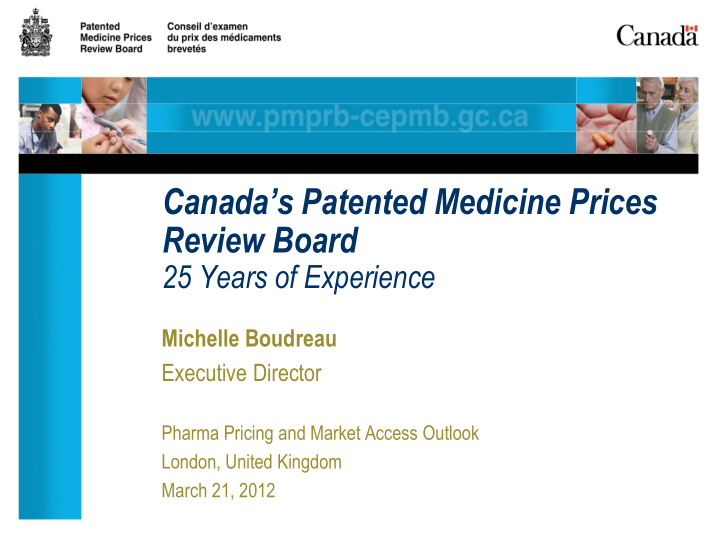



Canada’s Patented Medicine Prices Review Board 25 Years of Experience Michelle Boudreau Executive Director Pharma Pricing and Market Access Outlook London, United Kingdom March 21, 2012
Outline ________________________________________________ Overview of the PMPRB Canada Compared to the World Decisions of Interest Strengths and Challenges of the Canadian Price Regulatory System Common Challenges Regulator and Regulatee Relationship Looking Forward 2
Overview of the PMPRB ________________________________________________ Established in 1987 as consumer protection pillar via amendments to Patent Act The PMPRB is an independent quasi-judicial body with a dual mandate: Regulatory : To ensure that prices charged by patentees for patented medicines sold in Canada are not excessive Reporting : To report on pharmaceutical trends of all medicines and on R&D spending by pharmaceutical patentees Jurisdiction Regulate prices patentees charge (i.e., factory-gate price) for patented drug products sold in Canada, to wholesalers, hospitals or pharmacies, for human and veterinary use 3
Canada Compared to the World ________________________________________________ Canadian prices comparatively higher than a number of OECD countries 2.50 Avg Bilateral Foreign-to-Canadian Price Ratios: Top 300 selling oral solids in Canada 2.00 1.50 1.00 0.50 0.00 IMS Health Data, 2010 4
Canada Compared to the World (cont’d) ________________________________________________ Growth in drug sales outpacing comparator countries 5
Canada Compared to the World (cont’d) ________________________________________________ In 2005 and 2010, Canadian drug sales accounted for 2.4% and 2.7%, respectively, of the global ma rket Small, but a growing market 6
Canada Compared to the World (cont’d) ________________________________________________ Reference pricing at introduction and for existing drugs based on 7 comparator countries – France, Germany, Italy, Sweden, Switzerland, UK, and USA Policy changes in these countries impact prices in Canada Recently, Germany cited most often as pivotal introductory price Cost containment measures in Germany likely to lead to lower introductory prices in Canada Between 2008 to 2010, prices in Germany were the pivotal introductory price 25%, 58%, 60% of the times, respectively, by way of the Highest International Price Comparison test 7
Decisions of Interest ______________________________________________ Matter Issue Court Proceedings ratio-Salbutamol Jurisdictional issue: Whether Issue before the Federal Court HFA, Teva the Board has the authority to of Canada Canada regulate prices of ‘patented (formerly generics’ ratiopharm Inc.) Celgene Jurisdictional issue: Does the Supreme Court of Canada Corporation, and Board have the authority to confirmed: the patented regulate the prices of patented - the Board’s authority to regulate medicine drugs sold to Canadians prices of patented drugs Thalomid pursuant to Health Canada’s available under SAP Special Access Programme - the purpose of the legislation to (SAP) protect consumers from excessive pricing of patented medicines sold in Canada 8
Strengths and Challenges of the Canadian Price Regulatory System ________________________________________________ Pharmaceutical Regulation in Canada is a shared 1) responsibility PMPRB Jurisdiction covers patented drug products sold in Canada, whether through market approval or under Health Canada’s Special Access Programme (i.e., market approval not required) Over Life of Patent Health Canada Health Canada Review For Safety, Efficacy & Quality Post-Market Surveillance Market Approval Private Drug Plan Reimbursement Public Drug Plan Reimbursement Common Drug Individual Federal/Provincial Review Public Drug Plan Listing 9
Strengths and Challenges of the Canadian Price Regulatory System (cont’d) ______________________________________________ High level of compliance 2) On average, 93-95% overall compliance 2010 New drug Existing drug Total products products Total 68 1128 1196 Within 48 906 954 Guidelines Under review 11 9 20 Does not 2 133 135 trigger Under 7 78 85 investigation Price Hearings 2 2 10
Strengths and Challenges of the Canadian Price Regulatory System (cont’d) ________________________________________________ New levels of therapeutic improvements and associated 3) price tests better recognize and reward innovation Scientific review process establishes 4 levels of therapeutic improvement Reference domestic and foreign ex-factory market prices to reward innovation PMPRB establishes the price ceiling, not the selling price of 4) patented drug products Patentees have flexibility to set price up to price ceiling No jurisdiction over: Non-patented drug products Prices beyond the factory-gate prices 11
Strengths and Challenges of the Canadian Price Regulatory System (cont’d) ________________________________________________ Current Guidelines 5) Ongoing consultations and dialogue with key stakeholders (e.g., P/Ts, private payers, patentees) to ensure currency and effectiveness Canada: A federation of 13 Provinces and Territories 6) P/Ts privately and independently negotiate product listing agreements for public plans Some provinces have stronger negotiation powers Inconsistent access to certain drug products across the country Tradeoffs between transparency and confidentiality Reimbursement of drug products via private, P/T, or federal plans Most Canadians insured by 3 rd party payers 12
Strengths and Challenges of the Canadian Price Regulatory System (cont’d) ________________________________________________ Price ceiling set at introduction 7) Subsequently, growth of Average Transaction Price (ATP) limited to changes in CPI No price test subsequent to introduction No mechanism to re-bench based on new science 13
Common Challenges ________________________________________________ Similar challenges to other jurisdictions regarding transparency of drug pricing Next wave of new drugs (e.g., biologics) expected to be costly Defining therapeutic value and innovation and how to assess vis-à-vis sustainable pricing policies for payers? Networking with foreign regulators Information sharing Learning from shared experiences Dealing with global pricing strategies 14
Regulator and Regulatee Relationship ________________________________________________ PMPRB Regulatory Framework not as daunting as it may appear: Regular meetings and open dialogue with patentees (e.g., advisory assistance on pricing) Success stories: Co-operative dialogue with Rx&D, Industry Canada, and Canadian Institute for Health Research (CIHR) on R&D spending and definition Engaging with Canadian Generic Pharmaceutical Association (CGPA) to discuss regulatory options for generics Annual outreach sessions Board members’ engagement with stakeholders on Guidelines and other issues 15
Looking Forward ________________________________________________ Canadian-EU Comprehensive Trade Agreement (CETA) If proposal implemented, longer period of PMPRB regulation over patented drugs; but could also cause a re-evaluation of the balance between intellectual/industrial policies and health care/drug costs Ongoing engagement and outreach with stakeholders Board adopted two priorities: alternate dispute resolution (ADR) to further enhance compliance reducing regulatory burden Continued engagement with international organizations 16
Thank you. Merci. michelle.boudreau@pmprb-cepmb.gc.ca PMPRB Website: www.pmprb-cepmb.gc.ca Follow us on twitter @PMPRB_CEPMB 17
Recommend
More recommend